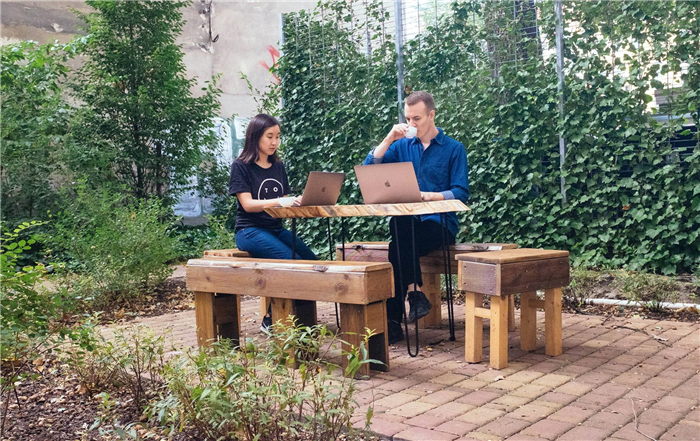My co-founder Andrew and I created Canny, a SaaS tool for collecting and managing customer feedback and building product roadmaps, from scratch.
Canny is entirely self-funded and profitable, recently hitting $800K in annual recurring revenue. We have a growing team of seven.
But it wasn’t always this way. Initially, Canny consisted of just the two of us.
Here’s our journey as entrepreneurs and the lessons we learned from growing a self-funded company.

Andrew and I met during my internship at Facebook. During that time, we started working together on a tool called Product Pains (which later became Canny).
It began as my thesis project, a tool for users to provide feedback on different products. We felt that companies didn’t care about the opinions of users like us. We knew there had to be a solution for this.
While I was still in school, Andrew worked on Product Pains as a side project. Eventually, we both quit our full-time jobs to build and launch Product Pains, which later evolved into Canny.
Contents
- 1 Lessons from scaling Canny and growing our team
- 2 To grow, you can’t do everything
Lessons from scaling Canny and growing our team
Starting a business is challenging, but growing one presents a whole new set of difficulties.
Being a SaaS company, your situation may differ depending on the type of business you run. If you’re a first-time founder, here’s our advice for effectively scaling your team.
1. Focus on matching skill sets and teamwork
Having compatibility within your team is crucial. From the beginning, it’s important to ensure that you and your founding team work well together.
Before Andrew and I started Canny, we had already collaborated on several smaller projects. We even won $45,000 in a hackathon at one point. It was clear that we made a good team.
This was vital when it came to starting a business. We knew we were a strong team.
As an engineer and designer pairing, we could build a software product without hiring for a while. This allowed us to develop Canny without needing additional personnel.
Our skill sets were complementary, offering a significant advantage. Starting with a small team is easier when co-founders have skills that complement rather than overlap each other.
Takeaways:
- Choose co-founders with whom you have tested compatibility.
- Complementary skill sets make it easier to start with a small team.
2. Do a lot with limited resources
At the beginning of a startup, affording a large team is usually not possible. Prioritize sustainable growth while keeping costs low.
Initially, we focused on building the product because we couldn’t afford to hire anyone. This limitation made the decision straightforward.
We also decided not to pursue venture capital funding. Many startups fundraise to quickly scale their teams, but we wanted to build a profitable, sustainable company without giving away ownership.
Not being able to pay anyone turned out to be an advantage. It taught us patience, and we knew that hiring would only be possible if the business was doing well.
Takeaways:
- Take advantage of being able to focus on your strengths without the need to hire initially.
- Be resourceful in the early stages, especially if you’re bootstrapped.
- If you can’t afford to hire after being in operation for some time, reevaluate your profitability.
3. Build a team starting with high-impact areas
Transitioning from a founders-only team to a larger one is a significant step. Be selective about the people you bring on board as a new startup with a small team.
When expanding our team, the first step was identifying the areas with the most impact. We asked ourselves:
– Which role will contribute the most to our growth?
– Which tasks take up a significant amount of our time?
– In which areas do we lack expertise or enjoyment?
We enjoy handling support and interacting with customers. However, doing everything ourselves was distracting due to sporadic requests. Hence, our first hire focused on finding an expert in customer success.
Andrew and I are not marketers, so we recognized the importance of hiring someone for marketing to drive Canny’s growth.
We acknowledged that a sales hire could come later since we could handle demos ourselves at that point. It was essential to prioritize roles that would have the most significant impact in the beginning.
Approaching hiring carefully was crucial, especially since we operate remotely. We emphasize finding individuals who are a good fit for our team and communicate well.
Takeaways:
- First non-founder team members should fill roles with a significant impact on growth.
- Consider areas where you lack expertise or dislike working.
- Thoroughly vet candidates for both their skills and fit within the team.
4. Trust those to whom you entrust your "baby"
As founders, you bear the weight of overseeing everything, which can be overwhelming if you aren’t an expert in every aspect.
However, giving away responsibility can be scary. It’s crucial to choose carefully when hiring and hire experts. Junior team members may not be the best choice for early hires.
The more your team members can own their roles, the better. Look for individuals who can take ownership of their area and make decisions. Set goals collaboratively and ensure accountability for meeting them.
The less you have to micromanage, the better. It frees up your time and energy while allowing you to trust that your "baby" is in capable hands.
Takeaways:
- Hire experts who can take ownership of their roles.
- Ownership and decisiveness matter beyond just skill set.
- Set goals and trust your team to meet them without excessive oversight.
5. Embrace the role of a manager
Managing a team presents one of the most significant challenges of growing a business. If you’ve been solely focused on product development, adapting to a managerial position can be difficult.
Recognize that leading a team is not just about growing your business—it’s also about helping your employees grow. Those you hire show faith in your idea.
Regular check-ins and one-on-one meetings are crucial. Use these meetings to discuss roadblocks, progress, and how your team members feel at work.
As a first-time manager, it’s essential to ensure that your team feels supported instead of suffocated.
Takeaways:
- Prepare for the transition from "doer of all things" to manager.
- Regularly communicate with your team and offer support.
To grow, you can’t do everything

To scale, build a team. You can’t do everything. Remember these points to establish a successful team:
– Hire slowly and carefully.
– Maintain open communication. Share what’s working and what isn’t, and listen to your team’s feedback.
– Trust your hires to minimize micromanagement. Hire experts who can take ownership.
– Accept that mistakes happen and they’re not permanent or catastrophic.
While growing pains are inevitable, they’re positive. Giving away ownership is necessary; founders can’t carry the company alone.
Ultimately, you’ll have more talented team members who excel in their respective areas, facilitating growth. Building our team has been incredibly rewarding.
Hello!
I’m Andrew Brooks, a seasoned finance consultant from the USA and the mind behind phonenumber247.com.
My career is built on a foundation of helping individuals and businesses thrive financially in an ever-changing economic landscape. At phonenumber247.com, my aim is to demystify the complex world of finance, providing clear, actionable advice that can help you navigate your financial journey with confidence. Whether it’s personal finance management, investment strategies, or understanding the nuances of market dynamics, I’m here to share insights and tools that can propel you towards your financial goals.
Welcome to my digital space, where every piece of advice is a step closer to financial clarity and success!
